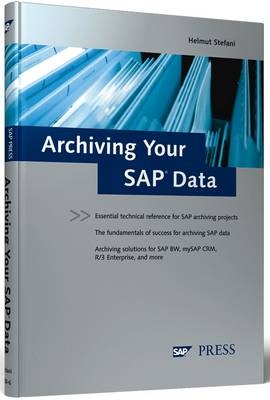
Archiving Your SAP Data
SAP Press (Verlag)
978-1-59229-008-6 (ISBN)
- Titel erscheint in neuer Auflage
- Artikel merken
Helmut Stefani studied applied linguistics at the Johannes Gutenberg University in Mainz/Germersheim, Germany, where he graduated as a technical translator for English and Spanish. After working in England he returned to Germany to work for an American company as a CAD software localization specialist. He has worked at SAP as an information developer and product management specialist in data archiving since 1997, and has jointly authored several publications on this subject.
Preface Acknowledgments Introduction 1 The Basics of Data Archiving 1.1 The mySAP.com E-Business Platform 1.1.1 The components of mySAP.com 1.1.2 Web Programming with the SAP Web Application Server 1.2 Data Archiving as a Part of mySAP Technology 1.2.1 The Benefits of Data Archiving 1.2.1.1 System Availability 1.2.1.2 Resource Usage 1.2.1.3 Response Times 1.2.2 Scope of Performance 1.2.3 Areas of Use 1.2.4 The Archive Development Kit 1.2.5 The Archiving Object 1.3 The Data Archiving Process 1.3.1 Accessing Archived Data 1.3.2 Storing Archive Data 1.4 Performance Aspects 1.5 Archiving Projects 1.5.1 The Right Moment 1.5.2 Data Prevention 1.6 Taxation Requirements Placed on Archived Data 1.6.1 Audit Information System 1.6.2 Data Retention Tool 2 Data Archiving Processes 2.1 Checking archivability 2.1.1 Linked Application Data 2.1.2 Performing the Archivability Check 2.2 Main Data Archiving Processes 2.2.1 Writing Data from the Database to the Archive 2.2.2 Deleting Data from the Database 2.2.2.1 Deleting after Writing 2.2.2.2 Deleting in Parallel with Writing 2.2.3 Storing Archive Files (optional) 2.3 Other Processes and Tasks 2.3.1 Accessing Archived Data 2.3.1.1 Evaluating Archive Files 2.3.1.2 Displaying Archived Single Objects 2.3.2 Reloading Archived Data 2.3.3 Executing Preprocessing and Postprocessing Programs 3 Storing Archived Data 3.1 Criteria for Selecting a Storage Strategy 3.1.1 Security 3.1.1.1 How Secure is the Storage Path? 3.1.1.2 How Secure is the Storage Itself? 3.1.1.3 What Security Possibilities does the Storage System Offer? 3.1.2 Costs 3.1.2.1 Purchase Costs 3.1.2.2 Operating Costs 3.1.3 Integration 3.1.3.1 How does the Storage System Fit the Existing IT Landscape? 3.1.3.2 Besides Data Archiving, How Does Storage Add Value? 3.1.4 Performance 3.1.4.1 Parallel Task Processing 3.1.4.2 Block-by-Block Access 3.1.5 Long-Term Storage 3.2 Storage in a Certified Storage System 3.2.1 Definitions: ArchiveLink, KPro, CMS 3.2.2 What is ArchiveLink? 3.2.2.1 The Central Task of ArchiveLink 3.2.2.2 The Term Document 3.2.2.3 Document Inquiries 3.2.3 Document Scenarios 3.2.3.1 Workflow-Based Document Scenarios 3.2.3.2 BarcodeScenario 3.2.3.3 Outgoing Documents 3.2.3.4 Print Lists 3.2.4 Interface to External Systems 3.2.4.1 Communication 3.2.4.2 Certifying Storage Systems 3.2.4.3 Certified Systema and SAP Content Server 3.2.5 Storing Archive Files 3.2.5.1 Asynchronous Storage 3.2.5.2 Synchronous Storage 3.2.6 Known Technical Problems with Archive File Storage 3.2.6.1 Synchronous Problem 3.2.6.2 Security Hole 3.2.6.3 Performance Problem 3.2.7 Access to Archive Files 3.2.8 Known Technical Problems Accessing Archive Files via ArchiveLink 3.2.9 Advantages of Using ArchiveLink 3.3 Storage via HSM Systems 3.3.1 What is HSM? 3.3.2 Storing Archive Files 3.3.3 Accessing Archive Files 3.3.4 Typical Technical Problems 3.3.5 Advantages of Using HSM systems 3.4 Manual Storage 3.4.1 Direct Integration 3.4.2 Indirect Integration 3.4.3 Advantages and Disadvantages of Manual Storage 3.5 Summary 4 Accessing Archived Data 4.1 Introduction 4.1.1 What is Not Covered in this Chapter 4.1.1.1 Print List Storage 4.1.1.2 Document Storage 4.1.1.3 Reloading 4.1.1.4 DART 4.1.1.5 Financial Bookkeeping Audit Trails 4.1.1.6 Accessing Stored Archive Files 4.2 The Basics 4.3 Sequential Read Programs 4.4 Direct Access 4.5 Archive Information System 4.5.1 Creating an Infostructure 4.5.2 Activating an Infostructure 4.5.3 Building an Infostructure 4.5.4 Evaluating an Infostructure 4.5.5 Removing an Infostructure 4.5.6 Creating a Field Catalog 4.5.6.1 Creating a Field Catalog with a Source Table 4.5.6.2 Creating a Field Catalog with Several Source Tables 4.5.6.3 Typical Pitfalls when Creating Field Catalogs 4.6 Archive Access Based on the Archive Information System 4.7 Document Relationship Browser 4.7.1 Connected Object Types in Detail 4.7.1.1 Accounting Document 4.7.1.2 Cost Accounting Document 4.7.1.3 Sales Order 4.7.2 Configuring the Document Relationship Browser 4.7.2.1 Presetting the Entry Programs 4.7.2.2 Choosing Entry List Fields 4.7.2.3 Choosing Object Types to be Displayed 4.7.2.4 Choosing Fields in DRB 5 Technology and Administration 5.1 The Basic Technology of SAP Archiving Solutions: The Archive Development Kit 5.1.1 ADK Classification and Components 5.1.2 ADK as Run-Time Environment 5.1.3 ADK as Development Environment 5.1.3.1 Developing New Archiving Objects 5.1.3.2 Expanding SAP Archiving Objects 5.1.4 Data Archiving and Unicode 5.2 Tasks of the Data Archiving Administrator 5.2.1 The Role of the "Data Archiving Administrator" 5.2.2 Monitoring Archiving Sessions 5.2.2.1 Archive Management 5.2.2.2 Data Archiving (DA) Monitor 5.2.3 Security Versus Performance 5.2.3.1 Verifying Archive Files 5.2.3.2 Checking File Access During Archive Selection 5.2.3.3 Changing the Order: Storing Before Deleting 5.2.4 Data Archiving Statistics 5.2.5 Reorganizing the Database After Data Archiving 5.3 Automated Live Operation 5.3.1 Periodic Archiving 5.3.2 Scheduling Data Archiving Jobs 5.3.2.1 Job Types 5.3.2.2 Using Server Groups 5.3.3 Suspending and Continuing Archiving Jobs 5.3.4 Possibilities for Automating Dependent Processes 5.3.5 Controlling Data Archiving Jobs Using External Job Schedulers 5.3.5.1 Scheduling Write Jobs 5.3.5.2 Scheduling Delete Jobs 5.3.5.3 Outlook 5.4 Application-Independent Errors and Their Recovery 5.4.1 Behavior in Case of Abnormal Program Termination 5.4.1.1 Abnormal Program Termination during the Write Phase 5.4.1.2 Abnormal Program Termination during the Delete Phase 5.4.2 Typical Pitfalls 5.4.2.1 Access to File System Not Possible 5.4.2.2 Insufficient Memory in File System 5.4.2.3 Overflow of System Log File for Database Updates 5.4.2.4 Database Error ORA-1555 - Snapshot Too Old (Only in Oracle Database System) 5.4.2.5 Database Lock Problems 6 Data Archiving in Various Components of mySAP.com 6.1 SAP R/3 Enterprise 6.1.1 Archiving in Financial Bookkeeping (FI) 6.1.1.1 Data Prevention 6.1.1.2 Customizing 6.1.1.3 Data Archiving 6.1.1.4 Accessing Archived Data 6.1.2 Archiving in Cost Accounting (CO) 6.1.2.1 Table COEP in Context 6.1.2.2 Object Number and Object Type 6.1.2.3 Analyzing Overhead Cost Controlling Tables 6.1.2.4 Data Prevention - Line Item Summarizing 6.1.2.5 Choosing Archiving Objects 6.1.2.6 CO_ITEM: Central Archiving Object 6.2 CRM Server 6.2.1 The CRM Server in the mySAP CRM Solution 6.2.2 Special Features of Data Archiving with CRM Server 6.2.3 The Relationship between Business Objects and Archiving Objects 6.2.4 The Three-Phase Model of Data Archiving 6.2.5 Cross-Archiving-Object Programs for Continuous Data Archiving 6.2.6 The CRM Business Process Data Model 6.2.7 The Archiving Object CRM_ACT_ON 6.2.8 Summary and Outlook 6.3 SAP Business Information Warehouse 6.3.1 SAP BW in mySAP.com 6.3.1.1 Technical Basics 6.3.1.2 Considerations for Data Archiving 6.3.2 Data Archiving in SAP BW 6.3.3 Modeling Archiving Objects 6.3.4 The Data Archiving Process 6.3.4.1 Writing Data to the Archive 6.3.4.2 Deleting Data in the Database 6.3.5 Typical Errors and How to Eliminate Them 6.3.6 Accessing Archived Data 6.3.7 Outlook 7 Planning and Executing Archiving Projects 7.1 Introduction 7.1.1 Setting up an Archiving Project Early 7.1.2 Setting up an Archiving Project Late 7.1.3 Considerations in the Field of Data Archiving 7.2 Procedures after ASAP Implementation Phases 7.3 Project Phases 7.3.1 Project Preparation 7.3.1.1 Assembling the Project Team 7.3.1.2 Database Analysis 7.3.1.3 Creating the Blueprint 7.3.2 Business Blueprint: Design and Conception 7.3.2.1 Creating a Business Blueprint 7.3.3 Implementation 7.3.3.1 Configuration and Customizing 7.3.3.2 Integration Testing 7.3.4 Production Preparation 7.3.4.1 Checking the Settings and Notes 7.3.4.2 Test Phase 7.3.4.3 End-user Training 7.3.4.4 Release for the Live System 7.3.5 Go Live & Support 7.3.5.1 Live Setup 7.3.5.2 Implementing a Long-term Archiving Plan 7.3.5.3 Project End Workshop .4 Quality Assurance in the Project 7.5 Executing an Archiving Project Using SD as an Example 7.5.1 Introduction 7.5.2 Project Preparation 7.5.2.1 Assembling the Project Team 7.5.2.2 Analysis 7.5.2.3 Preliminary Concept 7.5.3 Business Blueprint 7.5.3.1 Blueprint 7.5.4 Implementation 7.5.5 Production Preparation 7.5.6 Go Live & Support 7.5.6.1 Preparing and Executing Data Archiving 7.5.7 Example: Archiving a Sales Document 7.6 Critical Success Factors in an Archiving Project 7.7 Choosing the Right Residence Times .8 Choosing the Right Archiving Sequence A An Example of an Object Description for the Blueprint B Checklists for Archiving Projects C Other Information and Services C.1 Information C.2 Services C.3 Training D Glossary E Acronyms and Abbreviations F List of References G The Authors Index
| Erscheint lt. Verlag | 1.8.2005 |
|---|---|
| Verlagsort | Maryland |
| Sprache | englisch |
| Maße | 180 x 230 mm |
| Einbandart | gebunden |
| Themenwelt | Mathematik / Informatik ► Informatik ► Netzwerke |
| Informatik ► Weitere Themen ► Hardware | |
| ISBN-10 | 1-59229-008-6 / 1592290086 |
| ISBN-13 | 978-1-59229-008-6 / 9781592290086 |
| Zustand | Neuware |
| Informationen gemäß Produktsicherheitsverordnung (GPSR) | |
| Haben Sie eine Frage zum Produkt? |
aus dem Bereich



